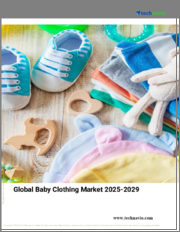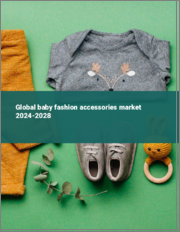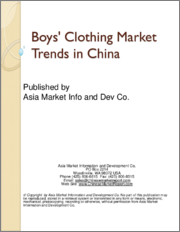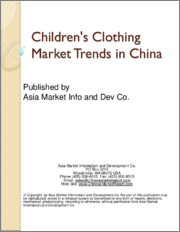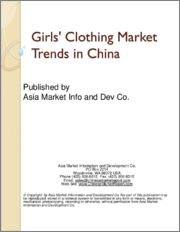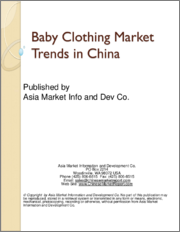
|
시장보고서
상품코드
1585432
세계의 아기 의류 시장 : 유형별, 소재별, 최종 사용자별-예측(2025-2030년)Baby Apparel Market by Type (Bottom Wear, Top Wear), Material (Cotton, Wool), End-user - Global Forecast 2025-2030 |
||||||
아기 의류 시장은 2023년에 112억 달러로 평가되었고, 2024년에는 125억 8,000만 달러로 추정되며, CAGR 12.76%로 성장할 전망이고, 2030년에는 259억 8,000만 달러에 도달할 것으로 예측됩니다.
아기 의류 시장에는 바디 슈트, 수면 웨어, 아우터 웨어, 포멀웨어, 캐주얼 웨어 등 유아용 의류가 폭넓게 포함되어 있습니다. 이러한 제품의 필요성은 유아의 급속한 성장과 발달로 인한 것이며 의복의 크기와 기능을 자주 변경해야 합니다. 게다가 아기 의류의 요구는 쾌적성, 안전성, 패션성에 대한 부모의 선호에 의해 야기되며, 이는 문화적 규범, 동향, 사회경제적 요인의 영향을 받습니다. 이 시장의 용도는 온라인 소매점, 아기 용품 전문점, 백화점 등 다양한 유통 채널을 통해 확산되어 있으며, 부모, 친척, 선물 구매자 등을 포함한 최종 사용자를 대상으로 하고 있습니다. 시장 성장에 영향을 미치는 주요 요인으로는 신흥 시장의 출생률 증가, 가처분 소득 증가, 패션 및 유기농 의류에 대한 부모의 의식 고조 등이 있습니다. 게다가 전자상거래와 디지털 마케팅으로의 전환은 특히 부모가 편의성과 상품의 다양성을 요구하게 되어 새로운 기회를 가져오고 있습니다. 기업은 현대 소비자 수요에 부응하기 위해 지속 가능한 소재와 아기의 건강을 모니터링하는 스마트 의류와 같은 혁신적인 기술에 주력해야 합니다. 그러나 시장은 엄격한 안전 규제와 가격 압력으로 이어지는 높은 경쟁과 같은 제약에 직면하고 있습니다. 또한 선진국의 출생률 변동도 과제가 되고 있습니다. 이러한 과제를 극복하기 위해 기업은 다기능 의류 개발이나 친환경 소재 활용 등 제품 개발에 기술을 활용하여 혁신을 일으킬 수 있습니다. 개인화된 쇼핑 경험을 위한 AI에 대한 투자와 소비자의 선호도를 예측하기 위한 빅 데이터 분석의 활용도 성장에 박차를 가할 수 있습니다. 시장 경쟁이 치열해지고 있으며 시장 점유율을 확보하고 장기 성장을 가속하기 위해 지속적인 혁신과 전략적 제휴가 필요합니다.
| 주요 시장 통계 | |
|---|---|
| 기준년(2023년) | 112억 달러 |
| 예측년(2024년) | 125억 8,000만 달러 |
| 예측년(2030년) | 259억 8,000만 달러 |
| CAGR(%) | 12.76% |
시장 역학 : 빠르게 진화하는 아기 의류 시장의 주요 시장 인사이트 공개
아기 의류 시장은 수요 및 공급의 역동적인 상호 작용에 의해 변모하고 있습니다. 이러한 시장 역학의 진화를 이해함으로써 기업은 충분한 정보를 바탕으로 투자결정, 전략적 의사결정, 새로운 비즈니스 기회를 획득할 수 있습니다. 이러한 동향을 종합적으로 파악함으로써 기업은 정치적, 지리적, 기술적, 사회적, 경제적 영역에 걸친 다양한 리스크를 경감할 수 있을 뿐만 아니라, 소비자 행동과 그것이 제조 비용 또는 구매 동향에 미치는 영향을 보다 명확하게 이해할 수 있습니다.
- 시장 성장 촉진요인
- 아기의 안전성과 쾌적성에 관한 의식의 고조
- 의류 디자인과 소재의 기술 혁신 증가
- 아기 케어 제품에 대한 지출 증가, 재사용 가능하고 세탁 가능한 기저귀에 대한 수요 증가
- 시장 성장 억제요인
- 고비용의 제품, 농촌에서의 낮은 보급률
- 시장 기회
- 바이오센서 아기 의류 등 스마트 아기 의류의 출현
- 아기 의류 및 양말 제품의 혁신과 신제품 발매의 진전
- 시장의 과제
- 의류 생산에 있어서의 숙련 노동자의 부족
Porter's Five Forces : 아기 의류 시장을 탐색하는 전략 도구
Porter's Five Forces 프레임 워크는 시장 상황경쟁 구도를 이해하는 중요한 도구입니다. Porter's Five Forces 프레임 워크는 기업의 경쟁력을 평가하고 전략적 기회를 탐구하는 명확한 기술을 제공합니다. 이 프레임 워크는 기업이 시장 내 세력도를 평가하고 신규 사업의 수익성을 결정하는 데 도움이 됩니다. 이러한 인사이트를 통해 기업은 자사의 강점을 활용하고, 약점을 해결하고, 잠재적인 과제를 피할 수 있으며, 보다 강인한 시장에서의 포지셔닝을 보장할 수 있습니다.
PESTLE 분석 : 아기 의류 시장에서 외부 영향 파악
외부 거시 환경 요인은 아기 의류 시장의 성과 역학을 형성하는 데 매우 중요한 역할을 합니다. 정치적, 경제적, 사회적, 기술적, 법적, 환경적 요인 분석은 이러한 영향을 탐색하는 데 필요한 정보를 제공합니다. PESTLE 요인을 조사함으로써 기업은 잠재적인 위험과 기회를 더 잘 이해할 수 있습니다. 이 분석을 통해 기업은 규제, 소비자 선호, 경제 동향의 변화를 예측하고 앞으로 예상되는 적극적인 의사 결정을 할 준비를 할 수 있습니다.
시장 점유율 분석 : 아기 의류 시장 경쟁 구도 파악
아기 의류 시장의 상세한 시장 점유율 분석을 통해 공급업체의 성과를 종합적으로 평가할 수 있습니다. 기업은 수익, 고객 기반, 성장률 등 주요 지표를 비교하여 경쟁 포지셔닝을 밝힐 수 있습니다. 이 분석을 통해 시장 집중, 단편화, 통합 동향을 밝혀내고 벤더들은 경쟁이 치열해지는 가운데 자사의 지위를 높이는 전략적 의사 결정을 내리는 데 필요한 지식을 얻을 수 있습니다.
FPNV 포지셔닝 매트릭스 : 베이비 의류 시장에서 공급업체의 성능 평가
FPNV 포지셔닝 매트릭스는 아기 의류 시장에서 공급업체를 평가하는 중요한 도구입니다. 이 행렬을 통해 비즈니스 조직은 공급업체의 비즈니스 전략과 제품 만족도를 기준으로 평가하여 목표에 맞는 충분한 정보를 바탕으로 의사 결정을 내릴 수 있습니다. 네 가지 사분면을 통해 공급업체를 명확하고 정확하게 세분화하여 전략 목표에 가장 적합한 파트너 및 솔루션을 파악할 수 있습니다.
전략 분석 및 추천 : 아기 의류 시장에서 성공에 대한 길을 그립니다.
아기 의류 시장의 전략 분석은 세계 시장에서의 존재를 강화하려는 기업에게 필수적입니다. 주요 자원, 역량 및 성과 지표를 검토함으로써 기업은 성장 기회를 파악하고 개선을 위해 노력할 수 있습니다. 이러한 접근 방식을 통해 경쟁 구도에서 과제를 극복하고 새로운 비즈니스 기회를 활용하여 장기적인 성공을 거둘 수 있는 체제를 구축할 수 있습니다.
이 보고서는 주요 관심 분야를 포괄하는 시장의 종합적인 분석을 제공합니다.
1. 시장 침투 : 현재 시장 환경의 상세한 검토, 주요 기업의 광범위한 데이터, 시장 도달범위 및 전반적인 영향력을 평가합니다.
2. 시장 개척도 : 신흥 시장의 성장 기회를 파악하고 기존 분야의 확장 가능성을 평가하며 미래 성장을 위한 전략적 로드맵을 제공합니다.
3. 시장 다양화 : 최근 제품 출시, 미개척 지역, 업계의 주요 진보, 시장을 형성하는 전략적 투자를 분석합니다.
4. 경쟁 평가 및 정보 : 경쟁 구도를 철저히 분석하여 시장 점유율, 사업 전략, 제품 포트폴리오, 인증, 규제 당국 승인, 특허 동향, 주요 기업의 기술 진보 등을 검증합니다.
5. 제품 개발 및 혁신 : 미래 시장 성장을 가속할 것으로 예상되는 최첨단 기술, 연구개발 활동, 제품 혁신을 강조합니다.
또한 이해관계자가 충분한 정보를 얻고 의사결정을 할 수 있도록 중요한 질문에 대답하고 있습니다.
1. 현재 시장 규모 및 향후 성장 예측은?
2. 최고의 투자 기회를 제공하는 제품, 부문 및 지역은 어디입니까?
3. 시장을 형성하는 주요 기술 동향 및 규제의 영향은?
4. 주요 벤더의 시장 점유율 및 경쟁 포지션은?
5. 벤더 시장 진입 및 철수 전략의 원동력이 되는 수익원과 전략적 기회는 무엇인가?
목차
제1장 서문
제2장 조사 방법
제3장 주요 요약
제4장 시장 개요
제5장 시장 인사이트
- 시장 역학
- 성장 촉진요인
- 아기의 안전과 쾌적함에 대한 의식의 고조
- 의류 디자인과 소재에 있어서의 혁신의 진전
- 아기 케어 제품에 대한 지출 증가와 재사용 가능하고 세탁 가능한 기저귀에 대한 수요 증가
- 억제요인
- 고가의 제품과 농촌에서의 낮은 보급률
- 기회
- 바이오센서 아기 의류 등 스마트 아기 의류의 등장
- 아기 의류 및 양말 제품에서 제품 혁신과 신제품 출시의 진전
- 과제
- 의류 생산에 있어서의 숙련 노동자의 부족
- 성장 촉진요인
- 시장 세분화 분석
- Porter's Five Forces 분석
- PESTEL 분석
- 정치적
- 경제
- 사교
- 기술적
- 법률상
- 환경
제6장 아기 의류 시장 : 유형별
- 하의
- 상의
제7장 아기 의류 시장 : 소재별
- 코튼
- 울
제8장 아기 의류 시장 : 최종 사용자별
- 남자아기
- 여자아기
제9장 아메리카의 아기 의류 시장
- 아르헨티나
- 브라질
- 캐나다
- 멕시코
- 미국
제10장 아시아태평양의 아기 의류 시장
- 호주
- 중국
- 인도
- 인도네시아
- 일본
- 말레이시아
- 필리핀
- 싱가포르
- 한국
- 대만
- 태국
- 베트남
제11장 유럽, 중동 및 아프리카의 아기 의류 시장
- 덴마크
- 이집트
- 핀란드
- 프랑스
- 독일
- 이스라엘
- 이탈리아
- 네덜란드
- 나이지리아
- 노르웨이
- 폴란드
- 카타르
- 러시아
- 사우디아라비아
- 남아프리카
- 스페인
- 스웨덴
- 스위스
- 터키
- 아랍에미리트(UAE)
- 영국
제12장 경쟁 구도
- 시장 점유율 분석(2023년)
- FPNV 포지셔닝 매트릭스(2023년)
- 경쟁 시나리오 분석
- 전략 분석 및 제안
기업 목록
- Adidas AG
- Benetton Group
- Carter's, Inc.
- Cotton On Group
- Diesel
- Disney
- Dolce & Gabbana Srl
- Gildan Activewear SRL
- H&M Group
- HANESBRANDS INC.
- Mothercare plc
- NG Apparels
- Nike, Inc.
- RALPH LAUREN MEDIA LLC
- The Children's Place, Inc.
- The Gap, Inc.
The Baby Apparel Market was valued at USD 11.20 billion in 2023, expected to reach USD 12.58 billion in 2024, and is projected to grow at a CAGR of 12.76%, to USD 25.98 billion by 2030.
The baby apparel market encompasses a wide range of clothing designed for infants and toddlers, typically including bodysuits, sleepwear, outerwear, formal wear, and casual wear. The necessity for these products arises from the rapid growth and development of infants, requiring frequent changes in size and functionality of clothing. Additionally, the need for baby apparel is driven by parents' preferences for comfort, safety, and fashion, which are influenced by cultural norms, trends, and socioeconomic factors. The market's application extends through various distribution channels such as online retailers, specialized baby stores, and department stores, targeting end-users that include parents, extended family members, and gift buyers. Key factors influencing market growth include increasing birth rates in emerging markets, rising disposable income, and growing parental awareness of fashion and organic clothing. Furthermore, the shift towards e-commerce and digital marketing presents new opportunities, especially as parents seek convenience and product variety. Companies should focus on sustainable fabrics and innovative technologies, such as smart clothing that monitors the baby's health, to meet contemporary consumer demands. However, the market faces limitations like stringent safety regulations and high competition leading to pricing pressures. Additionally, the fluctuating birth rates in developed countries pose a challenging factor. To overcome these challenges, companies can innovate by leveraging technology in product development, such as creating multifunctional garments or utilizing eco-friendly materials. Investing in AI for personalized shopping experiences and leveraging big data analysis to predict consumer preferences can also spur growth. The market is characterized by a diverse array of players, from niche startups to established global brands, and it is increasingly competitive, prompting ongoing innovation and strategic partnerships to capture market share and foster long-term growth.
| KEY MARKET STATISTICS | |
|---|---|
| Base Year [2023] | USD 11.20 billion |
| Estimated Year [2024] | USD 12.58 billion |
| Forecast Year [2030] | USD 25.98 billion |
| CAGR (%) | 12.76% |
Market Dynamics: Unveiling Key Market Insights in the Rapidly Evolving Baby Apparel Market
The Baby Apparel Market is undergoing transformative changes driven by a dynamic interplay of supply and demand factors. Understanding these evolving market dynamics prepares business organizations to make informed investment decisions, refine strategic decisions, and seize new opportunities. By gaining a comprehensive view of these trends, business organizations can mitigate various risks across political, geographic, technical, social, and economic domains while also gaining a clearer understanding of consumer behavior and its impact on manufacturing costs and purchasing trends.
- Market Drivers
- Rising awareness about the safety and comfort of the baby
- Growing innovations in apparel design and material
- Increase in the spending on baby care products and rising demand for reusable and washable diapers
- Market Restraints
- High-cost products and low penetration in rural areas
- Market Opportunities
- Emergence of smart baby wears such as biosensor baby apparels
- Developments in product innovation and new product launch in baby apparels and footwear products
- Market Challenges
- Lack of skilled laborers for apparel production
Porter's Five Forces: A Strategic Tool for Navigating the Baby Apparel Market
Porter's five forces framework is a critical tool for understanding the competitive landscape of the Baby Apparel Market. It offers business organizations with a clear methodology for evaluating their competitive positioning and exploring strategic opportunities. This framework helps businesses assess the power dynamics within the market and determine the profitability of new ventures. With these insights, business organizations can leverage their strengths, address weaknesses, and avoid potential challenges, ensuring a more resilient market positioning.
PESTLE Analysis: Navigating External Influences in the Baby Apparel Market
External macro-environmental factors play a pivotal role in shaping the performance dynamics of the Baby Apparel Market. Political, Economic, Social, Technological, Legal, and Environmental factors analysis provides the necessary information to navigate these influences. By examining PESTLE factors, businesses can better understand potential risks and opportunities. This analysis enables business organizations to anticipate changes in regulations, consumer preferences, and economic trends, ensuring they are prepared to make proactive, forward-thinking decisions.
Market Share Analysis: Understanding the Competitive Landscape in the Baby Apparel Market
A detailed market share analysis in the Baby Apparel Market provides a comprehensive assessment of vendors' performance. Companies can identify their competitive positioning by comparing key metrics, including revenue, customer base, and growth rates. This analysis highlights market concentration, fragmentation, and trends in consolidation, offering vendors the insights required to make strategic decisions that enhance their position in an increasingly competitive landscape.
FPNV Positioning Matrix: Evaluating Vendors' Performance in the Baby Apparel Market
The Forefront, Pathfinder, Niche, Vital (FPNV) Positioning Matrix is a critical tool for evaluating vendors within the Baby Apparel Market. This matrix enables business organizations to make well-informed decisions that align with their goals by assessing vendors based on their business strategy and product satisfaction. The four quadrants provide a clear and precise segmentation of vendors, helping users identify the right partners and solutions that best fit their strategic objectives.
Strategy Analysis & Recommendation: Charting a Path to Success in the Baby Apparel Market
A strategic analysis of the Baby Apparel Market is essential for businesses looking to strengthen their global market presence. By reviewing key resources, capabilities, and performance indicators, business organizations can identify growth opportunities and work toward improvement. This approach helps businesses navigate challenges in the competitive landscape and ensures they are well-positioned to capitalize on newer opportunities and drive long-term success.
Key Company Profiles
The report delves into recent significant developments in the Baby Apparel Market, highlighting leading vendors and their innovative profiles. These include Adidas AG, Benetton Group, Carter's, Inc., Cotton On Group, Diesel, Disney, Dolce & Gabbana S.r.l., Gildan Activewear SRL, H&M Group, HANESBRANDS INC., Mothercare plc, NG Apparels, Nike, Inc., RALPH LAUREN MEDIA LLC, The Children's Place, Inc., and The Gap, Inc..
Market Segmentation & Coverage
This research report categorizes the Baby Apparel Market to forecast the revenues and analyze trends in each of the following sub-markets:
- Based on Type, market is studied across Bottom Wear and Top Wear.
- Based on Material, market is studied across Cotton and Wool.
- Based on End-user, market is studied across Boys and Girls.
- Based on Region, market is studied across Americas, Asia-Pacific, and Europe, Middle East & Africa. The Americas is further studied across Argentina, Brazil, Canada, Mexico, and United States. The United States is further studied across California, Florida, Illinois, New York, Ohio, Pennsylvania, and Texas. The Asia-Pacific is further studied across Australia, China, India, Indonesia, Japan, Malaysia, Philippines, Singapore, South Korea, Taiwan, Thailand, and Vietnam. The Europe, Middle East & Africa is further studied across Denmark, Egypt, Finland, France, Germany, Israel, Italy, Netherlands, Nigeria, Norway, Poland, Qatar, Russia, Saudi Arabia, South Africa, Spain, Sweden, Switzerland, Turkey, United Arab Emirates, and United Kingdom.
The report offers a comprehensive analysis of the market, covering key focus areas:
1. Market Penetration: A detailed review of the current market environment, including extensive data from top industry players, evaluating their market reach and overall influence.
2. Market Development: Identifies growth opportunities in emerging markets and assesses expansion potential in established sectors, providing a strategic roadmap for future growth.
3. Market Diversification: Analyzes recent product launches, untapped geographic regions, major industry advancements, and strategic investments reshaping the market.
4. Competitive Assessment & Intelligence: Provides a thorough analysis of the competitive landscape, examining market share, business strategies, product portfolios, certifications, regulatory approvals, patent trends, and technological advancements of key players.
5. Product Development & Innovation: Highlights cutting-edge technologies, R&D activities, and product innovations expected to drive future market growth.
The report also answers critical questions to aid stakeholders in making informed decisions:
1. What is the current market size, and what is the forecasted growth?
2. Which products, segments, and regions offer the best investment opportunities?
3. What are the key technology trends and regulatory influences shaping the market?
4. How do leading vendors rank in terms of market share and competitive positioning?
5. What revenue sources and strategic opportunities drive vendors' market entry or exit strategies?
Table of Contents
1. Preface
- 1.1. Objectives of the Study
- 1.2. Market Segmentation & Coverage
- 1.3. Years Considered for the Study
- 1.4. Currency & Pricing
- 1.5. Language
- 1.6. Stakeholders
2. Research Methodology
- 2.1. Define: Research Objective
- 2.2. Determine: Research Design
- 2.3. Prepare: Research Instrument
- 2.4. Collect: Data Source
- 2.5. Analyze: Data Interpretation
- 2.6. Formulate: Data Verification
- 2.7. Publish: Research Report
- 2.8. Repeat: Report Update
3. Executive Summary
4. Market Overview
5. Market Insights
- 5.1. Market Dynamics
- 5.1.1. Drivers
- 5.1.1.1. Rising awareness about the safety and comfort of the baby
- 5.1.1.2. Growing innovations in apparel design and material
- 5.1.1.3. Increase in the spending on baby care products and rising demand for reusable and washable diapers
- 5.1.2. Restraints
- 5.1.2.1. High-cost products and low penetration in rural areas
- 5.1.3. Opportunities
- 5.1.3.1. Emergence of smart baby wears such as biosensor baby apparels
- 5.1.3.2. Developments in product innovation and new product launch in baby apparels and footwear products
- 5.1.4. Challenges
- 5.1.4.1. Lack of skilled laborers for apparel production
- 5.1.1. Drivers
- 5.2. Market Segmentation Analysis
- 5.3. Porter's Five Forces Analysis
- 5.3.1. Threat of New Entrants
- 5.3.2. Threat of Substitutes
- 5.3.3. Bargaining Power of Customers
- 5.3.4. Bargaining Power of Suppliers
- 5.3.5. Industry Rivalry
- 5.4. PESTLE Analysis
- 5.4.1. Political
- 5.4.2. Economic
- 5.4.3. Social
- 5.4.4. Technological
- 5.4.5. Legal
- 5.4.6. Environmental
6. Baby Apparel Market, by Type
- 6.1. Introduction
- 6.2. Bottom Wear
- 6.3. Top Wear
7. Baby Apparel Market, by Material
- 7.1. Introduction
- 7.2. Cotton
- 7.3. Wool
8. Baby Apparel Market, by End-user
- 8.1. Introduction
- 8.2. Boys
- 8.3. Girls
9. Americas Baby Apparel Market
- 9.1. Introduction
- 9.2. Argentina
- 9.3. Brazil
- 9.4. Canada
- 9.5. Mexico
- 9.6. United States
10. Asia-Pacific Baby Apparel Market
- 10.1. Introduction
- 10.2. Australia
- 10.3. China
- 10.4. India
- 10.5. Indonesia
- 10.6. Japan
- 10.7. Malaysia
- 10.8. Philippines
- 10.9. Singapore
- 10.10. South Korea
- 10.11. Taiwan
- 10.12. Thailand
- 10.13. Vietnam
11. Europe, Middle East & Africa Baby Apparel Market
- 11.1. Introduction
- 11.2. Denmark
- 11.3. Egypt
- 11.4. Finland
- 11.5. France
- 11.6. Germany
- 11.7. Israel
- 11.8. Italy
- 11.9. Netherlands
- 11.10. Nigeria
- 11.11. Norway
- 11.12. Poland
- 11.13. Qatar
- 11.14. Russia
- 11.15. Saudi Arabia
- 11.16. South Africa
- 11.17. Spain
- 11.18. Sweden
- 11.19. Switzerland
- 11.20. Turkey
- 11.21. United Arab Emirates
- 11.22. United Kingdom
12. Competitive Landscape
- 12.1. Market Share Analysis, 2023
- 12.2. FPNV Positioning Matrix, 2023
- 12.3. Competitive Scenario Analysis
- 12.4. Strategy Analysis & Recommendation
Companies Mentioned
- 1. Adidas AG
- 2. Benetton Group
- 3. Carter's, Inc.
- 4. Cotton On Group
- 5. Diesel
- 6. Disney
- 7. Dolce & Gabbana S.r.l.
- 8. Gildan Activewear SRL
- 9. H&M Group
- 10. HANESBRANDS INC.
- 11. Mothercare plc
- 12. NG Apparels
- 13. Nike, Inc.
- 14. RALPH LAUREN MEDIA LLC
- 15. The Children's Place, Inc.
- 16. The Gap, Inc.






